Yellowstone Wolf: Tracking the Packs
Recent research
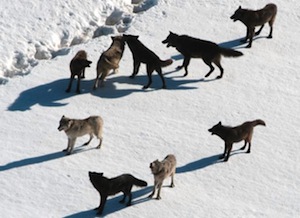
Temporal variability in wolf habitat selection
We know that wild animals do not wander across the landscape randomly, but they have preferences on which kind of habitats to use. For example, they might select meadows to rest, forests to feed, rivers to drink and boulders to build a den. However, when we study wildlife habitat selection we often observe animal movements over a short time (1 to 3 years), mainly due short-term funding. By doing so, we assume that habitat selection is a process that does not change through time. However, there are good reasons to believe that habitat selection may be a dynamic process.
Photo credit: NPS
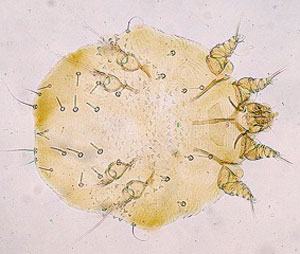
The dynamics and impacts of sarcoptic mange on Yellowstone's wolves
A tiny mite, introduced nearly a century ago to help eliminate predators, has made it back into Yellowstone's wolves and is affecting their survival and population dynamics. Learn how we study the mite and it's impacts on Yellowstone's wolves. By sharing your photos of Yellowstone's wolves, you, too, can contribute to this long-term dataset!
Photo credit: Alan R. Walker
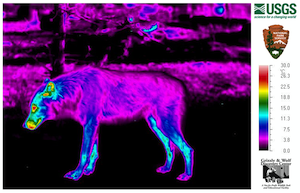
The caloric costs of infection with sarcoptic mange
Researchers are estimating the caloric costs for wolves affected with mange-induced hair loss. Using thermal cameras, researchers are estimating the amount of heat healthy, captive wolves lose from their body surface and are comparing this to remotely captured thermal images of mange-infected wolves inside Yellowstone. Increased energy demands associated with mange infection in winter conditions have important consequences for animal energy budgets, elk predation rates and, ultimately, wolf population growth.
Photo credit: USGS
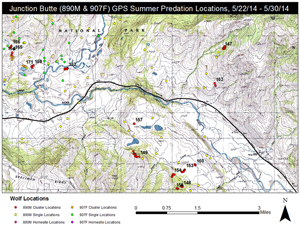
Seasonal variation in the predation patterns of Northern Range wolves
Wolf predation has been among the best-studied predator-prey relationships, and yet most of what we know comes from research during the winter months. Recent advances in GPS technology have allowed us to study predation during snow-free periods, revealing important seasonal differences in prey composition and kill rates. Find out how researchers are studying this variation and its implications for both wolf and elk population dynamics.
Map source: National Park Service
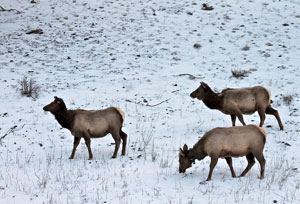
Influence of top-down and bottom-up forces on movement and habitat use of northern Yellowstone elk
The reintroduction of wolves to Yellowstone National Park has been hypothesized to create a "landscape of fear" in which elk avoid high-risk sites, thus promoting recovery of browse species such as aspen, willow, and cottonwood. The scientific evidence for this behaviorally-mediated trophic cascade within Yellowstone has been mixed. Find out how researchers are studying the relative influences of wolves and cougars (top-down forces) and food and snow depth (bottom-up forces) on elk movement and habitat use.
Photo credit: Michel Kohl
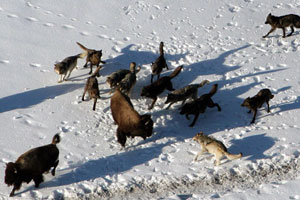
Wolf-Bison Interactions in Yellowstone National Park
What we know about how wolves hunt bison and how wolves affect bison behavior is still limited. Using long-term data, researchers are trying to understand how wolf pack size, bison herd size and environmental conditions affect wolves' ability to successfully hunt bison, and whether wolves have affected the number of bison wintering in fringe habitat in the park.
Photo credit: National Park Service
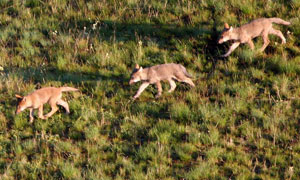
How does wolf social group structure and individual mortality affect group stability, reproduction, individual behavior, and ultimately population growth? Find out how researchers are using a range of tools, including simulation modeling, genetic data, and GPS locations to unravel the relationship between individuals, their packs, and overall population growth.
Photo credit: National Park Service
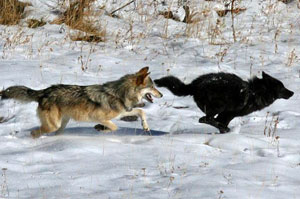
How do genes and environment interact? A focused long-term study on Yellowstone's wolves.
As an individual wolf has to deal with it's environment, ranging from stress due to social interactions or disease or limited resources, so do the genes it carries! By studying how gene are expressed differently in different environmental contexts (e.g. social rank, mange infection), we can learn more about the pieces of the puzzle that are involved in helping a complex organism function in a changing environment.
Photo credit: National Park Service
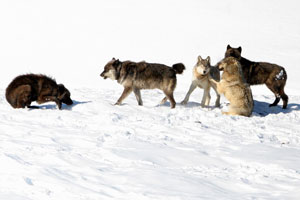
Evolution of coat color variation and molecular genetics of Yellowstone wolves
How did some wolves get to be gray, while others are black? Hint: It may have something to do with the domestic dog! We are using cutting-edge molecular techniques and the extensive Yellowstone wolf data set to understand the how, what, why, where, and when of coat color evolution in North American wolves.
Photo credit: National Park Service
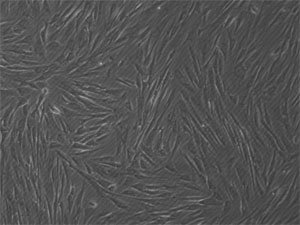
Establishment of wolf cell lines to investigate gene function in the North American gray wolf
Wolves that carry two copies of a specific gene mutation that confers black coat color exhibit extremely low lifetime reproductive success. Find out how researchers are testing hypotheses about how coat color is linked to immune function and how this might influence an individual's reproductive success and survival.
Photo credit: Rachel Johnston

Learn more about how researchers are using cutting edge RNA-sequencing technology to study how genes are expressed and how variation in gene expression might affect an individual's ability to cope with rapid environmental change.
Photo credit: Miguel Andrade

